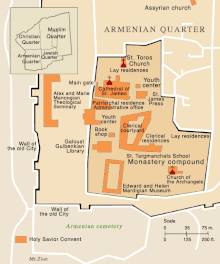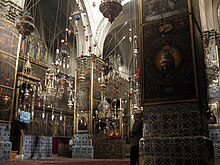Armenian quarter of Jerusalem
The Armenian Quarter of Jerusalem ( Arabic حارة الأرمن, Hebrew הַרֹבַע הַאַרְמֶנִי) is one of the four quarters of the old city of Jerusalem , the other three are the Jewish quarter , the Muslim quarter and the Christian quarter . It is located in the southwest corner of the old city and is accessible via the Zion Gate and the Jaffa Gate . It covers an area of 0.126 km² (126 dunams ), which corresponds to 14% of the entire old town. In 2007, 2,424 people lived here, this is the smallest population of all four quarters.
The quarter developed over the centuries around the Jacob's Cathedral , which still dominates the quarter today. The cathedral is the headquarters of the Armenian Patriarchate of Jerusalem .
history
Antiquity and the Middle Ages
The Armenians took as the first people in the world at the beginning of the 4th century under King Trdat III. the Christianity as a state religion in. Later in the fourth century, an Armenian community emerged in Jerusalem, and there has been an ongoing Armenian presence in that city ever since. The Armenian community became the most important representative of Monophysitism , while the other Christian denominations supported the doctrine of two natures . The Armenian colonization of Jerusalem served to guard the holy places of Christianity, especially the Church of the Holy Sepulcher . Under Byzantine rule, the Armenian community flourished over the next two centuries. It stretched beyond Mount Zion and became a center for Armenian pilgrims and scholars staying in the Holy City.
This heyday came to an end with the invasion of the Persians in 614; numerous churches and monasteries were destroyed. But during the time of the Crusaders , under the Christian Kingdom of Jerusalem , the Armenian community flourished again. Young Armenian women were married to European nobles, the best-known example being Morphia von Melitene , wife of Baldwin II .
Under Islamic rule
Under the rule of the Mamluks and in the subsequent Ottoman era, the Armenian community was able to maintain its importance as a Christian stronghold in Jerusalem. As a national church that also endeavored to maintain the Armenian language and culture, it was not subjected to Arabization - the adjustment to the local Arabic-speaking population. In 1833 the first printing house in Jerusalem was opened within the walls of the Armenian monastery. The city's first photo shop followed in 1855.
20th and 21st centuries
Until the beginning of the 20th century, the population in the Armenian quarter consisted mainly of clerics and a few lay families in the service of the Church. As a result of the genocide of the Armenians in World War I , around 20,000 Armenian refugees came to the region, many of whom remained in Jerusalem. Although this reduced the number of clergymen, the quarter remained a religious center.
In 1947, after the UN partition plan became known and before the outbreak of the Palestine War in 1948, around 1500 Armenians emigrated from Palestine to the Armenian Soviet Republic , which ushered in a decade-long decline of the Armenian community. She came under the increasing influence of the Middle East conflict . The conquest of East Jerusalem by Israel in the Six Day War in 1967 intensified the decline in the Armenian population.
At the Camp David meeting in 2000, Israel proposed a division of the Old City, according to which the Armenian and Jewish quarters would remain under Israeli rule, while the Christian and Muslim quarters would come under Palestinian rule. The Palestinian side, led by Yasser Arafat , rejected this proposal with the words: “The Armenian quarter is ours. We and the Armenians are one people. ”The proposal was also rejected by the Armenian, Greek Orthodox and Latin Patriarchates , which pointed to the bond between the Christian and the Armenian quarters in the Christian faith.
The majority of the estimated 8,000 to 10,000 Armenians in Israel (as of 2015) still live in the Armenian quarter of Jerusalem.
gallery
Entrance portal to St. Mark's Monastery
literature
- Max Küchler: Jerusalem. A handbook and study guide to the Holy City . 2nd Edition. Vandenhoeck & Ruprecht, Göttingen 2014, ISBN 978-3-647-50173-4 , p. 369–372 ( limited preview in Google Book search).
Web links
Individual evidence
- ^ Catholic Near East, July 1992
- ^ Dividing Jerusalem: Armenians on the line of confrontation
- ↑ Daniela Segenreich-Horsky: Neighbors - or related fate? The Armenian community in Israel . In: Neue Zürcher Zeitung of August 4, 2015, p. 43.
Coordinates: 31 ° 46 ′ 28 ″ N , 35 ° 13 ′ 44 ″ E









